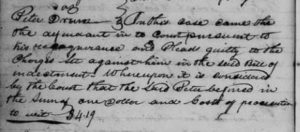
Genealogist purists do not like using indexes. I ‘m glad I’m not a purist as I recently found an interesting record by accident while using an index.
Monthly, I get an email from Familysearch.org with updates about the site. I always check out the section that lists the newly available online records. I find this especially important since the organization has stopped mailing microfilm to be viewed locally and a trip to Salt Lake City doesn’t seem to be in my immediate future so I need to keep checking to see when records of interest to me are available online.
One of the new links was to Ohio Wills and Estates to 1850: An Index by Carol Willsey Bell. I have many Ohio settlers from the early 1800’s and I wanted to use the index to make sure I didn’t overlook a probate record.
I understand the danger of simply citing an index as there might have been an error in recording the information. Personally, I view indexes like Ancestry hints. I might get lucky and I might not so let’s roll the dice and hope for the best.
I was searching for a probate record for Edward Adams, my elusive 3rd great grandfather who showed up in Perry County, Ohio about 1815 when he married Mary “Polly” Dennis Hodge, widow of John Hodge who had been killed in the War of 1812. Edward died shortly after being elected county auditor and was replaced in October 1822 according to the History of Fairfield and Perry Counties, Ohio.
I was delighted to find an entry on page 1 in Ohio Wills and Estates for Edward (Estate-1825 Perry Common Plea Minutes 64, page 10, page 68) and an Evi on page 2, who I was hoping to link together. I also found a Samuel I had not known about. One of Edward and Polly’s sons was named Evi, an unusual male name. The adult Evi in Perry County would have been about the right age to be a younger sibling of Edward so I was excited to see an entry for both men. I had also found a Susan Adams in the 1830 census in Perry County and I wondered if there was a connection. I’m now thinking she was the wife of Samuel. Reviewing my notes I noticed I had never checked the Common Plea Court records in Perry County and that’s where the index was directing me.
I quickly returned to the search engine at Familysearch.org and opened the microfilm for the Common Plea Court. I click on Minutes v. A 1818-1820 Minutes v. B 1820-1822 and without paying close attention to the middle of the title, noticed that the last entry was for 1828-1831. What I missed was that not all the records were filmed. And of course, some of the records I needed weren’t there.
Obviously, Bell had seen the complete records when she was recording the information for her book. This gives me hope that the records are somewhere out there where I may one day find them.
The limited info I did find showed that Evi was the administrator for Edward so I was pleased in that connection although it did not state their relationship. But I’m not disappointed at all because instead of finding what I was seeking, I discovered instead a court record for my 4th great grandfather, Peter Drum (1750-1837), which was on the page where I thought I’d find Edward’s estate info.
 1
1
I’m unable to find the bill of indictment so I don’t know what he was pleading guilty to. I did look up the fee of $4.19 and in converting it to today’s dollars – it’s about $20.00.
Here’s the weird part…the day before I had emailed the Fairfield County, Ohio Pioneer Society for a followup as earlier this year, I had submitted a lineage society application for Peter Drum and I had not heard from the organization. I could have used the above record as further proof of his residence but I hadn’t known it existed. The day after I found this record I received a response that the application for Peter Drum was accepted and I would receive more information in December.
Now I intend to go page by page through these court records to see if there are other interesting discoveries to be made. So glad winter is coming!
1 Court records, 1818-1854 Minutes v. B 1820-1822 Minutes, Peter Drum, Familysearch.org (https: familysearch.org: accessed 28 Oct 2018) p.2.





